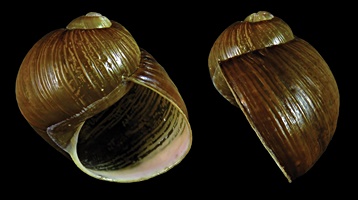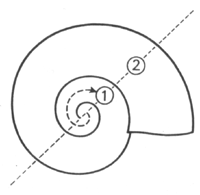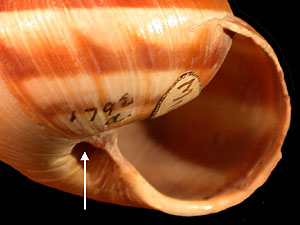 |
[RN] after Kerney et al. (1979)

The shell of a green snail (Cantareus apertus). Picture: F. Liberto.
[RN] after Kerney et al. (1979) |
||
 The shell of a green snail (Cantareus apertus). Picture: F. Liberto. |
To be able to clearly identify snails, it is necessary to first distinguish them from other, similar species. Identifying snails is usually done best by using shell characters. For slugs, other characters must be used.
In most field guides there are identification instructions. But to use those, it is necessary to know some basic terms of shell identification.
At first, the shell's size must be measured. Of main importance there are shell height, to be measured along the shell axis, and the shell width, to be measured across it. While a Roman snail's shell usually is about as wide as it is high (both between 30 and 35 mm), there are other land snails, whose shells are distinctly wider than high, or, like door snails, that are distinctly higher than wide: For example, a plaited door snail (Cochlodina laminata) shell is 4 mm wide, but 14 – 15 mm high.
 Additionally the whorls are counted. A whorl is one complete coil of the tube
of a snail's shell. Whorls are counted from the shell tip (apex) after one half
whorl down to the shell mouth. That means that in the illustration on the right,
2¼ whorls can be counted.
Additionally the whorls are counted. A whorl is one complete coil of the tube
of a snail's shell. Whorls are counted from the shell tip (apex) after one half
whorl down to the shell mouth. That means that in the illustration on the right,
2¼ whorls can be counted.
Looking at a snail shell, its apex pointing up and the shell mouth pointing to the front, it is also easily seen which way the shell is coiled. Shells of helicid snails in the major part of cases are coiled to the right (the shell mouth being on the right side of the shell), but there are the rare specimens coiled to the left and therefore called snail kings. In some snail groups other than the helicids, however, the coiling direction is even different between species and so is an important species identification character.
The shell form usually is quite similar among helicid snails: The shells are quite large, spherical and their wall is thick. But there are, of course, exceptions, looking, for example, at the extended, thinly walled shell of a green snail (Cantareus apertus, picture on the right).
Shell colour and surface structure are of the greatest importance in the identification of snails. In addition to a certain base colour, many snail shells also show a pattern of bands of different width and number. Also, the shell can be spotted or unicoloured. The shell surface may show ribs running across the whorl, or stripes, running alongside it. It may be granular, or smooth. This is a good moment to look at a brown garden snail's (Cornu aspersum) shell, on whose surface many of those characters can be found.
![]() Shell description of the brown garden snail (Cornu aspersum) (new window).
Shell description of the brown garden snail (Cornu aspersum) (new window).
 The umbilicus of Helix ligata. Picture: Dr. Karl Edlinger. |
Finally, the aperture (the shell mouth) can be rounded or oblique. It can be folded into an apertural lip, or it may have only a sharp rim. Some shells also have a bluntly thickened apertural rim not folded into a lip. Those characters also are well seen in a garden snail's (Cornu aspersum) shell, one of whose main characters is the distinct white apertural lip folded back.
f the inner walls of the shell tube do not touch where they coil around the shell axis, the shell spindle, called the columella, is hollow inside. The resulting opening is called the shell navel or umbilicus. A clearly visible umbilicus is rarely found among the helicid snails. Usually it is small, slit-like in appearance and concealed by the apertural lip folded back over it. One species it is well visible in, however, is Helix ligata, an Italian helicid snail (Picture on the left).